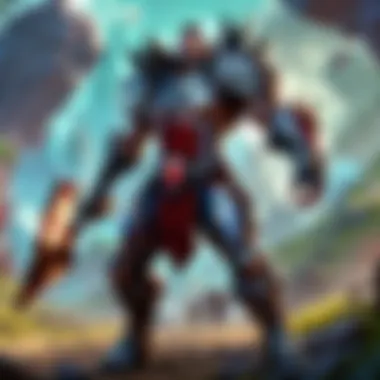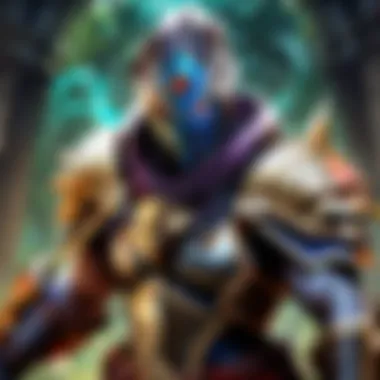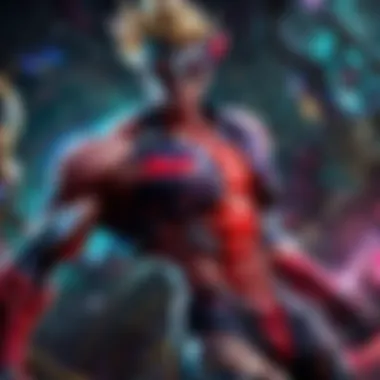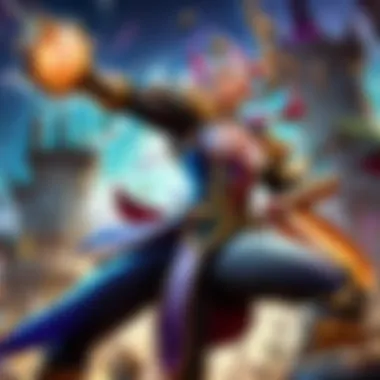The Convergence of League of Legends and Magic: The Gathering


Champion Spotlights
League of Legends and Magic: The Gathering, despite residing in distinct realms, share an undeniable allure - an allure intricately tied to their champions and planeswalkers. Champion Spotlights within these games serve as windows into the evolving landscape of characters, mechanics, and narratives that captivate players and spectators alike. Within League of Legends, a new champion spotlight offers an in-depth analysis of a freshly minted champion's strengths, weaknesses, and potential strategies in the Summoner's Rift. Similarly, in Magic: The Gathering, the unveiling of a new planeswalker sheds light on innovative deck-building possibilities and gameplay dynamics within various formats. Each new addition sparks debates, theorycrafting, and excitement within these fervent communities.
New Champion Spotlight
In League of Legends, the revelation of a new champion reverberates across the Rift, sending waves of anticipation through the player base. This section delves into the intricacies of recently introduced champions, dissecting their abilities, playstyles, and strategic impact on the ever-evolving meta. Whether it's a versatile jungler, a cunning mid-laner, or a steadfast tank, each champion brings a unique flavor to the game's competitive landscape. By analyzing their strengths, synergies, and potential counters, this spotlight enables players to adapt, innovate, and master the latest additions to their champion pool.
Champion Builds and Strategies
In the realm of Magic: The Gathering, planeswalkers represent pivotal figures whose decks and strategies revolve around their unique abilities and attributes. This subsection shifts the focus to crafting effective builds and strategies around popular champions in League of Legends and renowned planeswalkers in Magic: The Gathering. By exploring optimal itemization, skill orders, and situational plays, players can enhance their performance, outmaneuver opponents, and achieve victory with calculated precision. From aggressive burst builds to methodical control strategies, the art of leveraging a champion's strengths and exploiting their weaknesses forms the bedrock of success in both titles.
Introduction
In the vast landscape of gaming culture, few entities resonate as profoundly as League of Legends and Magic: The Gathering. This riveting article embarks on a journey to unravel the intricate connections between these two behemoths of the gaming world. By dissecting their fundamental cores with surgical precision, we aim to illuminate the underlying threads that weave these distinct tapestries together. The Introduction serves as a gateway to a realm where strategic prowess meets creative ingenuity, setting the stage for a profound exploration of gaming excellence.
Overview of League of Legends
League of Legends stands as a colossus in the realm of online battle arenas, beckoning players into a world where strategy reigns supreme. The complex tapestry of champions, each with their unique blend of skills and abilities, forms the foundation of this strategic masterpiece. Within the lanes of Summoner's Rift, players engage in a dance of wits and skill, where the slightest misstep can lead to triumph or defeat. The game's relentless evolution and ever-changing meta keep players on their toes, fostering a dynamic ecosystem where adaptability is key to success.
Insight into Magic: The Gathering
Magic: The Gathering transcends traditional card games, offering a realm where spells, creatures, and strategy converge in a harmonious symphony of gameplay. Each card in Magic is not just a piece of cardboard, but a strategic tool waiting to be unleashed. Delving into the intricate web of card interactions reveals a universe where foresight and planning pave the way to victory. The strategic depth of Magic lies not just in the cards themselves, but in the mind games and anticipatory strategies that players employ to outwit their opponents.
Significance of Both Games in Gaming Culture


League of Legends and Magic: The Gathering occupy pivotal positions in the tapestry of gaming culture, each bringing a unique flavor to the table. Where League dazzles with its fast-paced action and dynamic team strategies, Magic entices with its cerebral challenges and deep strategic planning. Both games serve as pillars of innovation, fostering communities that thrive on competition, creativity, and camaraderie. Their influence extends beyond the confines of the gaming world, permeating the realms of art, storytelling, and esports.
Gameplay Mechanics
Gameplay Mechanics serve as the foundation for any video game, dictating how players interact with the game world, make decisions, and ultimately experience the gameplay. In the context of League of Legends and Magic: The Gathering, understanding the intricacies of Gameplay Mechanics is crucial to mastering these complex and strategic games. Both titles offer unique mechanics that require players to think critically, strategize effectively, and adapt swiftly to ever-changing situations. Exploring the Gameplay Mechanics of League of Legends involves analyzing champion abilities, team compositions, objectives, and map control, all of which contribute to the game's strategic depth and competitive nature. On the other hand, Magic: The Gathering introduces a different set of Gameplay Mechanics focused on card interactions, deck building, resource management, and timing, requiring players to predict their opponents' moves and plan several steps ahead to secure victory. By delving into the Gameplay Mechanics of these two iconic games, players can enhance their skills, expand their strategic thinking, and experience the thrill of outsmarting their opponents in dynamic virtual battles.
Strategic Depth in League of Legends
Strategic Depth in League of Legends encompasses the multifaceted layers of decision-making, planning, and execution that define the game's competitive landscape. With over 150 champions, each with unique abilities, strengths, and weaknesses, mastering the strategic depth of League of Legends requires players to understand the importance of teamwork, communication, vision control, objective prioritization, and macro play. Successful teams leverage strategic depth to outmaneuver their opponents, secure key objectives, and coordinate seamless plays that lead to victory. The ability to think strategically, adapt to changing circumstances, and anticipate enemy movements is paramount in achieving success in the fast-paced world of League of Legends esports, where split-second decisions can determine the outcome of a match.
Complexity of Card Interactions in Magic: The Gathering
The Complexity of Card Interactions in Magic: The Gathering lies at the core of the game's intricate gameplay mechanics. With thousands of cards spanning various sets, formats, and mechanics, Magic: The Gathering presents players with a vast array of strategic choices and possibilities. Each card interaction involves evaluating multiple factors, such as card synergies, timing, stack resolution, and game state analysis, to determine the most optimal play in any given situation. Additionally, the intricate rules and interactions within Magic: The Gathering require players to possess a deep understanding of the game's mechanics, meta-strategies, and card interactions to navigate complex board states effectively. Whether crafting a combo deck, executing precise sequences of plays, or countering opponents' strategies, players must continually hone their knowledge and skills to excel in the ever-evolving metagame of Magic: The Gathering.
Skills Required for Success
Success in both League of Legends and Magic: The Gathering demands a diverse set of skills encompassing strategic acumen, adaptability, critical thinking, decision-making, and creativity. In League of Legends, players must master mechanics such as last-hitting, laning, team fighting, vision control, and objective securing, while also cultivating communication skills, teamwork, leadership, and emotional resilience to navigate the competitive landscape effectively. On the other hand, success in Magic: The Gathering necessitates expertise in deck building, card evaluation, resource management, probability assessment, adaptational strategies, and meta analysis. Players must possess a keen eye for detail, problem-solving abilities, pattern recognition, and the capacity to think several moves ahead to outplay their opponents and claim victory. Whether in the heat of a team fight or the midst of a complex card interaction, honing these skills is paramount for achieving success and standing out in the highly competitive realms of League of Legends and Magic: The Gathering.
Community Engagement
Community Engagement plays a pivotal role in fostering a sense of belonging and connection within the worlds of League of Legends and Magic: The Gathering. Thunderous bonds of camaraderie resonate through the digital realms, uniting players in a shared passion for competitive excellence. The virtual space transcends geographical barriers, allowing individuals from diverse backgrounds to interact and collaborate on a global scale. The thriving communities surrounding these games serve as incubators for innovation and camaraderie, where players can exchange strategies, celebrate victories, and form lasting friendships. In this article, the exploration of Community Engagement unfolds as a tapestry of shared experiences and collaborative endeavors, shedding light on the dynamic interactions that underpin the success of these gaming universes.
Online Communities and Forums
Online communities and forums act as crucial hubs of interaction, pulsating with the pulsating rhythm of discussion threads, epic tales, and strategic insights. These virtual spaces serve as digital agora for players to congregate, engage in debates, and seek advice on gameplay mechanics and strategies. From Reddit’s bustling subreddits to Discord servers abuzz with activity, players immerse themselves in a cornucopia of discussions, memes, and insightful analyses, weaving a rich tapestry of shared experiences. Through online forums, players can quicken their learning curve, stay abreast of meta shifts, and forge connections with like-minded enthusiasts, enriching their gaming journey with shared knowledge and camaraderie.


Tournaments and Competitive Scene
The competitive landscape of League of Legends and Magic: The Gathering is a vibrant arena pulsating with tension, skill, and nail-biting showdowns that captivate audiences worldwide. From grassroots tournaments to international championships, players grapple for supremacy, showcasing their strategic prowess and tactical acumen in high-stakes battles that elevate gaming to a level of artistry. These tournaments not only crown victors but also inspire aspirants, catalyzing a culture of relentless improvement and competitive spirit. Through these competitive events, players test their skills, forge rivalries, and form alliances, shaping the narrative of esports history with every move and decision.
Creative Content and Fan Contributions
Creative content and fan contributions imbue the worlds of League of Legends and Magic: The Gathering with a kaleidoscope of fan art, videos, cosplay, and fan fiction, enriching the tapestry of in-game experiences. Fans pour their passion and creativity into diverse forms of expression, from elaborate cosplay showcases to intricate fan theories that unravel the mysteries of the game worlds. Their contributions not only celebrate the immersive universes of both games but also serve as catalysts for community growth and engagement, inspiring others to dive deeper into the realms of creativity and imagination. In this digital age of content creation, fans play an instrumental role in shaping the narratives and mythologies that define the ethos of these iconic games, weaving a vibrant tapestry of fan-driven content that enriches the gaming experiences for all.
Updates and Expansions
Updates and Expansions hold a critical role in the evolution of both League of Legends and Magic: The Gathering. With the ever-changing landscape of competitive gaming, these updates provide players with fresh content, new challenges, and keep the gameplay experience engaging and dynamic. In the context of League of Legends, regular patches introduce balance changes, new features, and champions, altering the strategic meta and player dynamics. Similarly, in Magic: The Gathering, expansion sets bring forth new cards, mechanics, and strategies, revitalizing the card pool and reshaping the way the game is played. Understanding these updates and expansions is crucial for players seeking to stay competitive and adapt to the evolving environments of these iconic games.
Patch Updates in League of Legends
Within the realm of League of Legends, patch updates act as a cornerstone of the game's development, facilitating balance adjustments, bug fixes, and the introduction of new content. Each patch is meticulously crafted to address community feedback, tweak champion abilities, and refine gameplay mechanics. Patch notes dissect minute details of changes to individual champions, items, and game systems, influencing playstyles, team compositions, and overall strategies. Players closely monitor these updates to anticipate shifts in the meta, adapt their playstyles, and discover new synergies to master the game's strategic depth and complexity.
Expansion Sets in Magic: The Gathering
Magic: The Gathering boasts a rich history of expansion sets that not only expand the card pool but also introduce themes, mechanics, and narrative arcs. These expansion sets are meticulously designed to maintain game balance, foster creativity, and provide players with new deck-building possibilities. The release of each set is eagerly anticipated by the Magic community, as it signifies a fresh start, a new collection of cards to explore, and innovative strategies to develop. Whether drafting at a local game store or competing in high-level tournaments, players immerse themselves in the diverse worlds and intricate mechanics of each expansion set, continually reshaping the metagame.
Balancing Changes and Meta Shifts
Balancing changes and meta shifts are inherent to the competitive nature of both League of Legends and Magic: The Gathering. In League of Legends, balancing adjustments aim to ensure fair and diverse gameplay, preventing any one champion or strategy from dominating the meta. These changes not only influence individual champion win rates but also impact broader gameplay trends and strategies employed by professional players. Likewise, in Magic: The Gathering, meta shifts occur as new expansion sets are released, reshaping the card interactions, dominant archetypes, and optimal strategies. Adapting to these meta shifts is essential for players to stay ahead of the curve, refine their deck-building skills, and navigate the evolving landscape of competitive play.
Crossover Potential


Collaborative Events and Promotions
In the realm of gaming synergy, Collaborative Events and Promotions stand as pillars of connection bridging distinct worlds. When League of Legends teams up with Magic: The Gathering, it isn't merely a superficial blending of brands but a strategic intertwining that amplifies the experiences of both player bases. These events transcend traditional marketing ploys, offering players unique opportunities to immerse themselves in a fusion of gameplay dynamics and thematic elements. Whether through limited-time in-game events, cross-title rewards, or exclusive competitions, Collaborative Events and Promotions ignite excitement and foster camaraderie among the diverse gaming communities.
Shared Themes and Inspirations
Delving into the Shared Themes and Inspirations between League of Legends and Magic: The Gathering unveils a tapestry of interconnected narratives and design influences. Despite their distinct gameplay mechanics, both universes are intricately interwoven through shared motifs, character archetypes, and overarching themes. Exploring these commonalities not only enriches the gaming experience for enthusiasts of both titles but also offers a profound insight into the creative synergy that underpins their development. By unraveling the threads that bind these worlds together, players gain a deeper appreciation for the craftsmanship and storytelling prowess that set League of Legends and Magic: The Gathering apart in the vast expanse of video game and card game landscapes.
Player Experiences in Both Universes
At the heart of the convergence between League of Legends and Magic: The Gathering lies the immersive realm of Player Experiences. As individuals traverse through the multifaceted landscapes of these games, they embark on journeys that transcend mere entertainment, delving into realms of strategy, camaraderie, and personal growth. By immersing themselves in the challenges presented by each universe, players forge connections, hone their skills, and shape their identities within the expansive gaming community. This section sheds light on the parallel adventures undertaken by individuals entrenched in both worlds, illustrating how the unique dynamics of each game resonate with players on a profound level, enriching their gaming odysseys and fostering a sense of belonging within these vibrant ecosystems.
Conclusion
In this critical juncture of the article, we reflect upon the profound implications brought forth by the shared existences of League of Legends and Magic: The Gathering. Understanding the amalgamation of these two monumental games provides a gateway to exploring the diverse facets that define the contemporary gaming landscape. The undeniable significance of this convergence lies in the ability to transcend traditional gaming boundaries and offer a multi-dimensional experience that challenges the very core of strategic gameplay.
By dissecting the intricacies that each game presents individually and in unison, we uncover a tapestry of complexities and nuances that cater to a sophisticated audience hungry for intellectual stimulation. The interplay of mechanics, community engagement, and creative synergies showcases the immense potential that arises when two seemingly disparate worlds collide.
On a broader spectrum, the impact of League of Legends and Magic: The Gathering extends beyond mere entertainment; it exemplifies the evolution of gaming culture and the symbiotic relationship between developers and players. The evolution of these games mirrors the ever-changing landscape of cybersports and serves as a testament to the adaptability and innovation that drive the industry forward.
Reflecting on the Legacy of LoL and MTG
Delving into the profound heritage that League of Legends and Magic: The Gathering have sculpted over the years, we are confronted with a legacy that transcends mere gameplay mechanics. The legacy of these games is rooted in their ability to foster lasting communities, inspire creativity, and pave the way for future gaming endeavors.
League of Legends, with its strategic depth and ever-evolving gameplay, has set a standard for competitive gaming that few titles can match. The dedication of its player base and the continuous support from developers ensure that the legacy of LoL remains vibrant and enduring.
Magic: The Gathering, on the other hand, pioneered the collectible card game genre and revolutionized the way players interact with physical and digital mediums. Its intricate lore, diverse mechanics, and loyal community have solidified its position as a cultural icon, shaping the gaming landscape for decades to come.
Implications for Future Developments
The implications of this intersection extend to game developers, content creators, and players alike, ushering in a new era of cross-platform experiences and innovative game mechanics. By embracing the lessons learned from the legacies of LoL and MTG, future developments in the gaming industry are destined to be enriched with depth, creativity, and a sense of camaraderie that transcends virtual boundaries.







